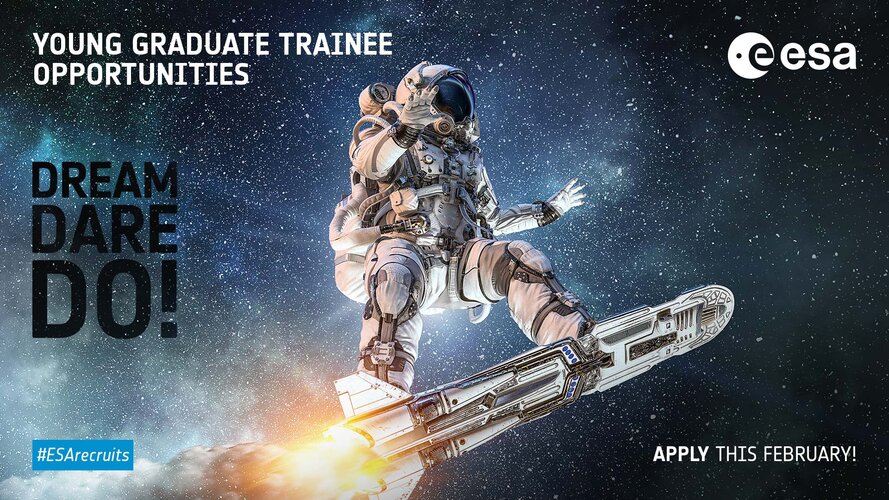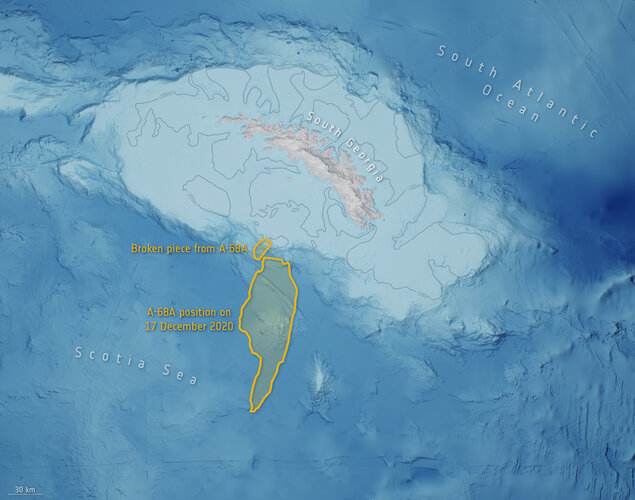
Copernical Team
How scientists tested the supersonic dynamic characteristics of the Tianwen-1 Mars Entry Capsule

Ready to become a YGT?

The call for 2022 Young Graduate Trainee opportunities is nearly open! Get ready to apply and prepare your CVs and cover letters ahead of schedule! Find out more about this year's call for applications below.
Russia's only female cosmonaut to travel to space in September

Russia's sole active female cosmonaut, Anna Kikina, is due to travel to the International Space Station in September on a Soyuz rocket, the national space agency said Thursday.
Kikina, a 37-year-old engineer, will be only the fifth professional woman cosmonaut from Russia or the Soviet Union to fly to space.
Last year, the Russian space agency Roscosmos said "our beauty" Kikina would fly aboard SpaceX's Crew Dragon as part of a cross-flights deal between Roscosmos and NASA.
On Thursday, Roscosmos said that if the two countries finalise the deal, Kikina will fly to space with the Americans in August, while NASA's Francisco Rubio will travel on a Soyuz.
But if the deal does not work out, she will travel to the ISS on a Soyuz rocket in September.
The last Russian woman to fly to space was Elena Serova, who spent 167 days aboard the ISS from September, 2014 to March, 2015.
Soviet cosmonaut Valentina Tereshkova became the first woman in space when she travelled into orbit on June 16, 1963.
Svetlana Savitskaya was the second woman in space, and the first woman to perform a spacewalk in July, 1984.
Mega iceberg released 152 billion tonnes of freshwater

In July 2017, a giant iceberg, named A-68, snapped off Antarctica’s Larsen-C ice shelf and began an epic journey across the Southern Ocean. Three and a half years later, the main part of iceberg, A-68A, drifted worryingly close to South Georgia. Concerns were that the berg would run aground in the shallow waters offshore. This would not only cause damage to the seafloor ecosystem but also make it difficult for island wildlife, such as penguins, to make their way to the sea to feed. Using measurements from satellites, scientists have charted how A-68A shrunk towards the end
Sulphur dioxide from Tonga eruption spreads over Australia
 Image:
The Hunga-Tonga-Hunga-Ha'apai volcano near Tonga in the South Pacific erupted with such force on 15 January that it is thought to be the biggest eruption recorded anywhere on the planet in 30 years.
Image:
The Hunga-Tonga-Hunga-Ha'apai volcano near Tonga in the South Pacific erupted with such force on 15 January that it is thought to be the biggest eruption recorded anywhere on the planet in 30 years. IMDO, MDA complete flight tests for the Arrow Weapon System and Arrow 3 Interceptor
 the Israel Missile Defense Organization (IMDO) of the Directorate of the Defense Research and Development (DDR and D) at Israel's Ministry of Defense, together with the U.S. Missile Defense Agency (MDA) and Israeli Defense Forces, conducted a successful flight test of the Arrow Weapon System (AWS) and the Arrow 3 interceptor at a test site in central Israel.
AWS radars detected the target
the Israel Missile Defense Organization (IMDO) of the Directorate of the Defense Research and Development (DDR and D) at Israel's Ministry of Defense, together with the U.S. Missile Defense Agency (MDA) and Israeli Defense Forces, conducted a successful flight test of the Arrow Weapon System (AWS) and the Arrow 3 interceptor at a test site in central Israel.
AWS radars detected the target China's rocket technology hits the ski slopes
 Who would ever have thought that technology used on China's largest carrier rocket would be used to improve the safety of skiers?
Chinese scientists have developed a strong ski helmet with space technology originally used on the Long March-5 rocket, the country's heaviest launch vehicle and the carrier of Mars probe Tianwen-1.
The helmet, designed by a team from the Dalian University
Who would ever have thought that technology used on China's largest carrier rocket would be used to improve the safety of skiers?
Chinese scientists have developed a strong ski helmet with space technology originally used on the Long March-5 rocket, the country's heaviest launch vehicle and the carrier of Mars probe Tianwen-1.
The helmet, designed by a team from the Dalian University Capturing all that glitters in galaxies with NASA's Webb
 Spirals are some of the most captivating shapes in the universe. They appear in intricate seashells, carefully constructed spider webs, and even in the curls of ocean waves. Spirals on cosmic scales - as seen in galaxies - are even more arresting, not only for their beauty, but also for the overwhelming amount of information they contain. How do stars and star clusters form? Until recently, a co
Spirals are some of the most captivating shapes in the universe. They appear in intricate seashells, carefully constructed spider webs, and even in the curls of ocean waves. Spirals on cosmic scales - as seen in galaxies - are even more arresting, not only for their beauty, but also for the overwhelming amount of information they contain. How do stars and star clusters form? Until recently, a co ASU astronomer finds star fuel surrounding galaxies
 Most galaxies, including our own, grow by accumulating new material and turning them into stars - that much is known. What has been unknown is where that new material comes from and how it flows into galaxies to create stars.
In a recently published study, Arizona State University astronomer Sanchayeeta Borthakur has identified the faint fuel reservoirs that surround galaxies, and how this
Most galaxies, including our own, grow by accumulating new material and turning them into stars - that much is known. What has been unknown is where that new material comes from and how it flows into galaxies to create stars.
In a recently published study, Arizona State University astronomer Sanchayeeta Borthakur has identified the faint fuel reservoirs that surround galaxies, and how this NASA's James Webb telescope completes mirror alignment, heads for orbit
 NASA's James Webb telescope completed alignment all 18 of its primary mirror segments and the secondary mirror on Wednesday, the agency reported.
NASA Administrator Bill Nelson shared the news, tipping his hat to the crew on Twitter.
"Congratulations to the teams that have been working tirelessly since launch to get to this point. Soon, Webb will arrive at its new home, L2," wrot
NASA's James Webb telescope completed alignment all 18 of its primary mirror segments and the secondary mirror on Wednesday, the agency reported.
NASA Administrator Bill Nelson shared the news, tipping his hat to the crew on Twitter.
"Congratulations to the teams that have been working tirelessly since launch to get to this point. Soon, Webb will arrive at its new home, L2," wrot 
